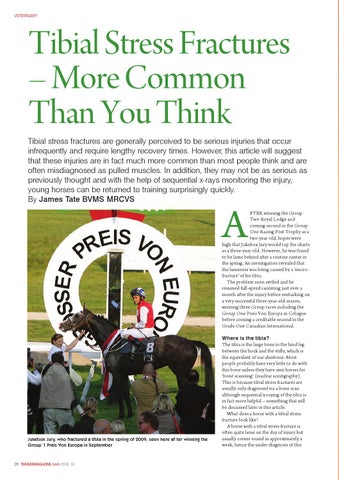TIBIAL FRACTURES ISSUE 30.qxd:Jerkins feature.qxd
20/5/10
20:09
Page 1
VETERINARY
Tibial Stress Fractures – More Common Than You Think
Tibial stress fractures are generally perceived to be serious injuries that occur infrequently and require lengthy recovery times. However, this article will suggest that these injuries are in fact much more common than most people think and are often misdiagnosed as pulled muscles. In addition, they may not be as serious as previously thought and with the help of sequential x-rays monitoring the injury, young horses can be returned to training surprisingly quickly. By James Tate BVMS MRCVS
A
FTER winning the Group Two Royal Lodge and coming second in the Group One Racing Post Trophy as a two-year-old, hopes were high that Jukebox Jury would top the charts as a three-year-old. However, he was found to be lame behind after a routine canter in the spring. An investigation revealed that the lameness was being caused by a ‘microfracture’ of his tibia. The problem soon settled and he resumed full-speed cantering just over a month after the injury before embarking on a very successful three-year-old season, winning three Group races including the Group One Preis Von Europa in Cologne before coming a creditable second in the Grade One Canadian International.
Jukebox Jury, who fractured a tibia in the spring of 2009, seen here af ter winning the Group 1 Preis Von Europa in September
28 TRAINERMAGAZINE.com ISSUE 30
Where is the tibia? The tibia is the large bone in the hind leg between the hock and the stifle, which is the equivalent of our shinbone. Most people probably have very little to do with this bone unless they have sent horses for ‘bone scanning’ (nuclear scintigraphy). This is because tibial stress fractures are usually only diagnosed via a bone scan although sequential x-raying of the tibia is in fact more helpful – something that will be discussed later in this article. What does a horse with a tibial stress fracture look like? A horse with a tibial stress fracture is often quite lame on the day of injury but usually comes sound in approximately a week, hence the under-diagnosis of this
